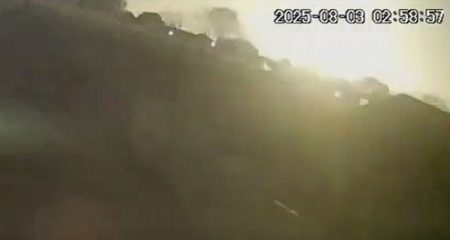
Residents of St Francis Bay in the Eastern Cape woke up to a series of flashing blue lights as a falling meteorite arched its way across the sky on Sunday morning.
The flashes were accompanied by a series of loud bangs that could be heard as far as Plettenberg Bay and Knysna, before the object crashed into the Indian Ocean, sending out shockwaves that shook windows up and down the coastline.
Video footage of the falling meteorite showed the object breaking up into as many as six parts as it streaked across the sky. Now a team of University of the Witwatersrand and Nelson Mandela Metropolitan University (NMMU) scientists are mobilising to identify the fallen object.
“It’s very preliminary,” said Prof Roger Gibson of the school of Geosciences at Wits University. “What we have confirmed is we have a bolide – a very bright light moving across the sky. That could be our own satellite junk or naturally occurring asteroid material. What we seem to have confirmed is there are pieces of meteorite that were found inland and we are trying to track those down.”
Reports of fragments being found in the Kirkwood area, some 100km from the crash site, have given the team, made up of members of the physics, astronomy and geosciences departments of both Wits and the NMMU, hope that they will get the opportunity to study and classify the fallen material.
According to Gibson, between 10 and 50 meteorite crashes occur on a daily basis worldwide, but most are never discovered because they are “lost” to the oceans. Canvassing the entire area where fragments could have potentially fallen is not feasible, and so Gibson and the team are relying on collecting more eyewitness accounts in an effort to determine the meteorite’s path through the atmosphere.
“The two points are 100km apart – this is exceptional, meaning there is a lot of land in between where there is a lot of material. But unless it falls on someone’s roof, you are looking for a needle in a haystack. This is an amazing opportunity for citizen science. How far were you from the sighting, what direction were you facing and at what angle did you observe from? We have a set of preliminary hypotheses and we must fill in the gaps – the public will be very useful for that,” said Gibson.
He said that once the fragments are found, they will be taken to a repository such as a museum or university. Once there, they will be analysed in various ways, including using microbeam analysis to identify the chemicals in the rock. These findings are then sent to the International Meteoritical Society, which confirms the correctness of the classification, also making it official.
“They can be very fragile in Earth’s atmosphere because they come from space where there is no oxygen or water [to react with],” said Gibson.
He warned people in the areas surrounding the suspected meteorite’s path to beware of meteorite buyers who might contact them and convince them to go out and source fragments in promise of financial return. “In South Africa, meteorites are heritage resources just like fossils, and they are illegal to sell – we need to protect this heritage.”
According to Gibson, if the fallen object turns out to be a meteorite, it will be the 52nd to be discovered in South Africa. Only 22 of the 51 meteorites recorded from South Africa are associated with falls that were observed and recorded; the rest are only finds.
‘Very excited’
The Eastern Cape is no stranger to debris of the extra-terrestrial kind. The earliest recorded meteorite to fall in the province is named the Cape of Good Hope. It fell to Earth in 1703 and weighed 136kg.
Since then, there have been nine other meteorite finds in the province, ranging in weight and composition from a few grams to more than a ton. The heaviest of these is named after the Kouga Mountains and weighs 107t. The meteorite was not observed falling to Earth but was discovered in the Kouga Mountains in 1903.
Read: Upcoming lunar and solar eclipses in South Africa
“We’re very excited, because only about 2% of all discovered meteorites are from observed falls and the last fall to land in South Africa was in Lichtenburg in 1953,” said Gibson. – © 2024 NewsCentral Media




